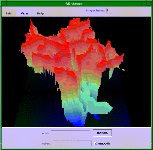|
|

Thomas Maxwell
410-326-7388
maxwell@cbl.umces.edu
http://kabir.cbl.umces.edu/Tom/Maxwell.html
Computer modeling is becoming an increasing important tool for understanding how our world works. Sentient beings learn best by hands-on experimentation. As the systems we are embedded in become increasingly complex, the capacity for understanding the dynamics of these systems through direct experimentation diminishes, and the importance of learning through interaction with virtual worlds increases. Traditionally, however, this learning opportunity has been available to small groups of highly trained scientific investigatiors. The purpose of this research is to open the simulation arena to a much wider set of participants, and facilitate the application of computer modeling to the study of complex multi-scale processes in support of science, education, and policy making on many levels. We will be demonstrating our integrated environment for high performance spatial modeling, called the Spatial Modeling Environment (SME). This environment, which transparently links icon-based modeling environments with advanced computing resources, allows modellers to develop simulations in a user-friendly, graphical environment, requiring no knowledge of computer programming. Automatic code generators construct (spatial) simulations and enable distributed processing over a network of parallel and serial computers, allowing transparent access to state-of-the-art computing facilities. The environment imposes the constraints of modularity and hierarchy in model design, and supports archiving of reusable model components defined in our Simulation Module Markup Language (SMML). The SME is one component of the Environmental Hydrology Workbench. This demo will highlight the SME java interfaces, which enable users to remotely configure, execute, control, and visualize complex spatial simulations through their Web browsers.
![]()
![[Alliance]](http://www.ncsa.uiuc.edu/includes/footer-alliancelogo2.gif)
|
|